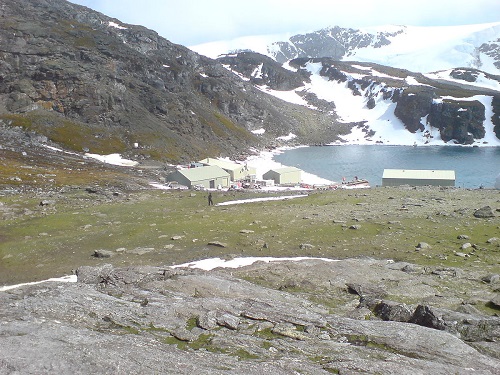Geologist and science writer Nina Morgan sympathises with some geological misunderstandings
Morgan, N., An easy mistake to make. Geoscientist 30 (7), 28, 2020
https://doi.org/doi: 10.1144/geosci2020-101, Download the pdf here
As a PhD student at University College London (UCL) studying microvertebrate fossils in the 1970s, palaeontologist Chris Duffin [b. 1951], now a Scientific Associate at the Natural History Museum in London, noticed something interesting. Examining acid-treated residues of microfossils from the Carboniferous Limestone from Wirksworth in Derbyshire, he came across what appeared to be articulated ostracod valves with a distinctive external sculpture. Unfamiliar with ostracod identification he did the sensible thing and took them to the Micropalaeontology Department at UCL for identification. Alan Lord [b. 1942], now an honorary co-worker at the Senckenberg Forschungsinstitut in Frankfurt, agreed they looked like ostracods, but being more familiar with Mesozoic forms, suggested they consult ostracod expert (and polymath) Eric Robinson [b. 1929]. Robinson immediately identified the 'ostracods' as very resistant seeds from local blackberry bushes and consoled Duffin by assuring him that generations of micropalaeontologists had made the same mistake.
a PhD student at University College London (UCL) studying microvertebrate fossils in the 1970s, palaeontologist Chris Duffin [b. 1951], now a Scientific Associate at the Natural History Museum in London, noticed something interesting. Examining acid-treated residues of microfossils from the Carboniferous Limestone from Wirksworth in Derbyshire, he came across what appeared to be articulated ostracod valves with a distinctive external sculpture. Unfamiliar with ostracod identification he did the sensible thing and took them to the Micropalaeontology Department at UCL for identification. Alan Lord [b. 1942], now an honorary co-worker at the Senckenberg Forschungsinstitut in Frankfurt, agreed they looked like ostracods, but being more familiar with Mesozoic forms, suggested they consult ostracod expert (and polymath) Eric Robinson [b. 1929]. Robinson immediately identified the 'ostracods' as very resistant seeds from local blackberry bushes and consoled Duffin by assuring him that generations of micropalaeontologists had made the same mistake.
Misunderstandings
No geological theories were harmed by that palaeontological misunderstanding. But a similar type of mistake in fossil identification held back the interpretation of the regional geological setting of The South Orkney Islands and the understanding of the geological history of Antarctica for more than 75 years.
The South Orkney Islands, located approximately eight hundred kilometres east of the tip of the Antarctic Peninsula, were first discovered in 1821 in the course of a voyage of exploration for sealing grounds. The first geological observations were made by a French expedition in 1838, but it was not until 1902 that the first rock samples were collected by the Edinburgh-based Scottish National Antarctic Expedition on the ex-whaling ship, Scotia. The geologist on board was Dr James Hunter Harvey Pirie [1878 – 1965], who also served as the expedition's medical officer and carried out bacteriological research.
The western islands in the South Orkney group are underlain by a metamorphic complex. In contrast, the smaller islands in the eastern part of the chain are composed of a sequence of greywacke and shale which closely resemble the Palaeozoic greywackes found in the Southern Uplands of Scotland. So when the samples were returned to Scotland, it was not too surprising that on examination by eminent geologists, including Benjamin Peach [1842 – 1926] and the graptolite expert Gertrude Elles [1872 – 1960], the indistinct fossil remains they contained were reported to be graptolites, a group of marine animals that appeared during the Cambrian and went extinct around 320 million years, during the Carboniferous.
One of the small islands in the eastern part of the group was christened Graptolite Island, and Elles identified the fossils as a species of Pleurograptus. On the basis of this lithological and fossil evidence the rocks were assumed to be of Lower Palaeozoic age. The idea that the rocks contained graptolites persisted until 1957, when the samples were re-examined and the 'graptolites' were identified as Triassic plant material.
Welcome to the club!
But the story didn't end there. In 1977, further samples were collected from bedded cherts on a rocky islet between two of the smaller islands in the South Orkney chain. These were shown to contain Triassic radiolaria and Permo-Triassic conodonts – so the assumption that there were graptolites in the rocks of Graptolite Island turned out to be wishful thinking. The idea that the rocks were of Lower Palaeozoic age had to be scrapped too.
It's comforting to know that even the experts can be fooled. But we're all always learning. So as Robinson smilingly said to Duffin: Welcome to the club!
End notes: Sources for this vignette include Welcome to the club! by Chris Duffin, included in Ericdotes, a collection of stories in appreciation of Eric Robinson (copies are available to buy at www.historyofgeologygroup.co.uk); Dalziel, I. W. D. 1979. The mythical graptolites of the South Orkney Islands. The Edinburgh Geologist, 6 , pp. 2 – 9; Stone, Phil, 2003, Fossils from the South Atlantic, The Edinburgh Geologist, 41, pp 14 – 18. I thank Renee Clary of Mississippi State University, US for inadvertently drawing my attention to this story in another context!
Author
Nina Morgan is a geologist and science writer based near Oxford. Her latest book, The Geology of Oxford Gravestones, is available via www.gravestonegeology.uk
Image: Factory Cove with Signy Research Station, Signy Island, South Orkney Islands (Ben Tullis, Wikipedia CC BY 2.0)